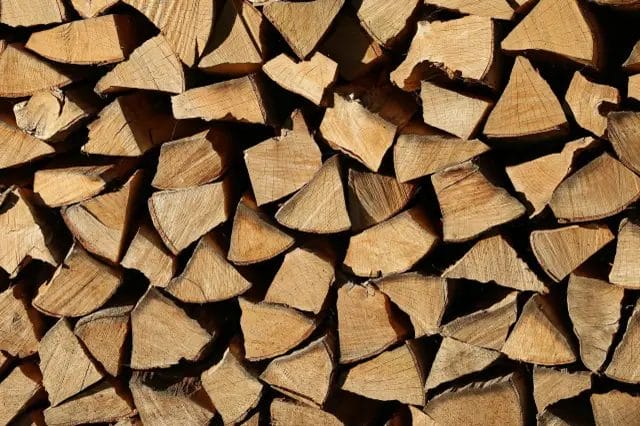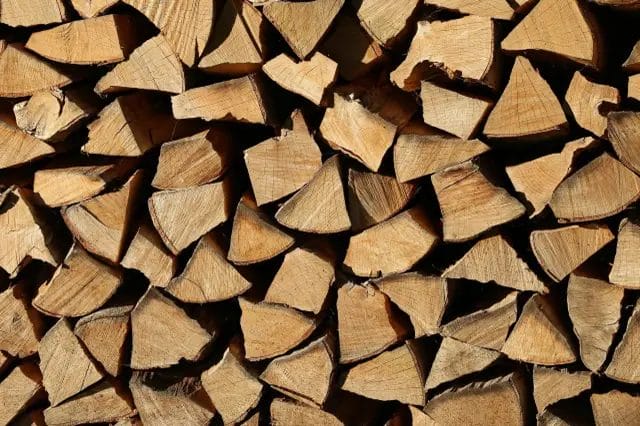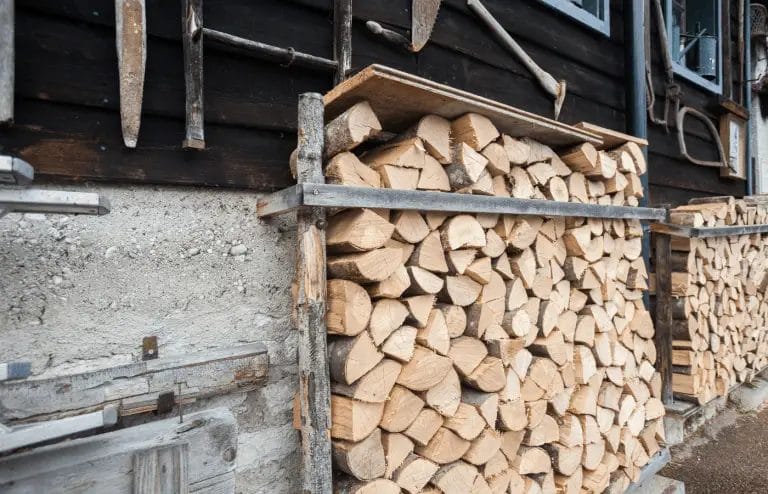Seasoned wood refers to wood that has been dried to reduce its moisture content below a certain level, typically around 20%. This process of drying allows the wood to be burned more efficiently and produce more heat when used as fuel. Seasoned wood is ideal for use in fireplaces, wood stoves, and other wood-burning appliances. It is also less likely to produce excessive smoke or emit harmful pollutants. Using seasoned wood not only provides better heating but also helps to prolong the lifespan of your heating equipment.

Benefits of Using Seasoned Wood
Using seasoned wood for various applications offers several advantages. Whether you’re using it for building furniture, constructing a deck, or as firewood, seasoned wood provides many benefits that make it a popular choice among homeowners and professionals alike. In this section, we will explore the key benefits of using seasoned wood.

1. Improved Stability
One of the primary benefits of using seasoned wood is its improved stability. Seasoned wood has undergone a drying process, which reduces its moisture content. This reduction in moisture helps to minimize shrinkage, warping, and cracking that can occur in unseasoned or green wood. By using seasoned wood, you can ensure that your project remains structurally sound and resilient to changes in humidity and temperature.
2. Enhanced Strength and Durability
Seasoned wood is known for its enhanced strength and durability compared to green wood. As the moisture content decreases during the seasoning process, the wood becomes stronger and more resilient. This makes it suitable for a wide range of applications, including building structures and furniture that require long-lasting performance. Using seasoned wood can help to prevent issues such as wood rot, decay, and insect infestation, which can compromise the integrity of your project.
3. Improved Workability
Another advantage of using seasoned wood is its improved workability. The drying process removes excess moisture from the wood, making it easier to cut, shape, and manipulate. This enhanced workability is particularly beneficial for woodworking projects that require precise cuts and intricate designs. Seasoned wood also tends to have less sap and resin, reducing the likelihood of clogging cutting tools and creating a cleaner working environment.
4. Consistent Appearance
Seasoned wood often has a more desirable and consistent appearance compared to green wood. As the wood dries, it develops a rich color and smooth texture, enhancing its visual appeal. This can be particularly important for projects such as furniture or flooring, where aesthetics play a significant role. Using seasoned wood allows you to achieve a uniform and attractive finish, creating a visually pleasing result.
5. Improved Burning Efficiency
When it comes to using wood for heating purposes, seasoned wood has a clear advantage. The reduced moisture content in seasoned wood means that it burns more efficiently and produces more heat compared to green wood. This increased burning efficiency translates into better fuel economy and lower emissions. Using seasoned wood in your fireplace or wood-burning stove can help you save on heating costs and reduce your environmental impact.
In summary, the benefits of using seasoned wood are numerous. From improved stability and enhanced strength to better workability and consistent appearance, seasoned wood offers significant advantages for various applications. Whether you’re a DIY enthusiast or a professional builder, opting for seasoned wood ensures that your projects are durable, visually appealing, and environmentally friendly.

How to Identify and Select Seasoned Wood
Choosing the right wood for your next woodworking project is essential for the success and longevity of your creation. One important factor to consider when selecting wood is its moisture content. Seasoned wood, also known as dry wood, is wood that has been dried to a specific moisture level, making it more stable and suitable for various applications. In this section, we will discuss how to identify and select seasoned wood for your woodworking projects.
1. Check the Appearance
One of the first things you can do to identify seasoned wood is to check its appearance. Seasoned wood tends to have a darker color compared to freshly cut or green wood. It might also display small cracks or splits on the surface, an indication that the wood has gone through the drying process. Additionally, seasoned wood is generally lighter in weight as the moisture has been reduced.
2. Measure the Moisture Content
To accurately determine if the wood is seasoned, you can use a moisture meter. A moisture meter is a handy tool that measures the moisture content of wood. Simply insert the probes into the wood, and the meter will display the percentage of moisture present. For seasoned wood, the ideal moisture content is typically around 6-8%. Any reading significantly higher indicates that the wood is not properly seasoned.
3. Knock on Wood
Another method to identify seasoned wood is by tapping on it. Take a wooden object and gently knock on the surface of the wood you want to inspect. Seasoned wood produces a hollow sound, while green or unseasoned wood tends to produce a dull thud. This is due to the air pockets created during the drying process in seasoned wood.
4. Consider the Weight
When selecting wood, the weight can also be an indicator of its moisture content. As mentioned earlier, seasoned wood is lighter in weight compared to freshly cut wood. Pick up the piece of wood you are considering and assess its weight. If it feels significantly heavier than expected, it may still contain excess moisture and is not properly seasoned.
5. Look for Wood with End Grain Exposure
Seasoned wood often has exposed end grain, which occurs when the ends of the wood are cut or not covered. This exposure allows the moisture to escape more easily, speeding up the drying process. When inspecting wood, check for signs of end grain exposure. If the wood has sealed ends or no visible end grain, it is likely not seasoned.
6. Consult with a Professional
If you are unsure about identifying seasoned wood on your own, it can be helpful to consult with a professional. Local lumberyards or woodworking shops often have knowledgeable staff who can assist you in selecting the right seasoned wood for your project. They can provide guidance and recommendations based on your specific needs and requirements.
In summary, selecting seasoned wood is crucial for the success of your woodworking projects. By checking the appearance, measuring the moisture content, tapping on the wood, considering the weight, looking for end grain exposure, and consulting with professionals, you can identify and select seasoned wood with confidence. Remember, seasoned wood is more stable and suitable for various woodworking applications, ensuring the durability and quality of your creations.

Proper Storage and Maintenance of Seasoned Wood
Wood is a versatile and popular building material, known for its durability and aesthetic appeal. However, in order to maintain its quality and prevent damage, it is important to store and maintain seasoned wood properly. In this section, we will discuss some essential tips and guidelines for the storage and maintenance of seasoned wood.1. Choosing a Proper Storage Location
The first step in maintaining seasoned wood is to select an appropriate storage location. Ideally, the storage area should be dry, well-ventilated, and protected from direct sunlight and excessive moisture. This will help prevent warping, cracking, and decay of the wood.2. Stacking and Organization
When storing seasoned wood, it is important to stack it properly. The wood should be placed in a neat and organized manner, with enough space between each piece for adequate airflow. This allows the wood to dry evenly and reduces the risk of mold or mildew growth.3. Elevating the Wood
To further protect the wood from moisture damage, it is recommended to elevate the stack off the ground. This can be achieved by using pallets or blocks to create a raised platform. Elevating the wood ensures that it is not in direct contact with moisture, preventing rot and decay.4. Covering the Wood
Covering the seasoned wood is crucial to shield it from direct exposure to rain or snow. Use a waterproof tarp or a specially designed wood cover to protect the stack. Ensure that the cover is securely fastened to prevent water from seeping in.5. Regular Inspection
Periodic inspection of the stored wood is essential to identify any signs of damage or infestation. Check for mold, insect activity, or any visible decay. Promptly address any issues to prevent further damage to the stored wood.6. Proper Ventilation
Maintaining proper ventilation in the storage area helps prevent the buildup of moisture. Good airflow allows the wood to dry effectively and reduces the risk of mold growth. Avoid storing wood in areas with high humidity or limited ventilation.7. Pest Control
Wood can attract pests such as termites, ants, and beetles. Implement preventive measures to keep pests at bay. Regularly inspect the storage area for signs of infestation and take appropriate actions, such as applying wood treatments or using pest-repellent products.8. Regular Cleaning
Cleaning the storage area and the wood stack is important to remove dirt, debris, and any organic matter that could attract pests or promote decay. Use a broom or brush to sweep the area and wipe down the wood if necessary.9. Proper Handling and Transportation
When moving or transporting seasoned wood, it is crucial to handle it with care. Avoid dragging or dropping the wood, as it can cause damage. Use appropriate lifting techniques and secure the wood properly during transportation to avoid accidents and prevent distortion. In summary, proper storage and maintenance are vital for preserving the quality and longevity of seasoned wood. By following these guidelines, you can ensure that your wood remains in optimal condition, ready for use in various projects. Remember to choose a suitable storage location, stack the wood correctly, cover it to protect from the elements, inspect regularly, maintain proper ventilation, control pests, clean the storage area, and handle the wood with care. Following these practices will help you make the most out of your seasoned wood and extend its lifespan.Common Mistakes to Avoid When Dealing with Seasoned Wood
Seasoned wood can be a great option for various woodworking projects. It is wood that has been dried to reduce moisture content, making it less prone to warping, shrinking, and other issues commonly associated with fresh or green wood. However, working with seasoned wood requires some caution and attention to detail to ensure the best results. Here are some common mistakes to avoid when dealing with seasoned wood:
- Not checking moisture content: One of the biggest mistakes people make when working with seasoned wood is assuming that it is completely dry. Even though it has been dried, there can still be some residual moisture present. It is essential to check the moisture content of the wood using a moisture meter to ensure it is suitable for your project.
- Ignoring proper storage: Seasoned wood should be stored in a dry and well-ventilated area to maintain its moisture content. Many DIY enthusiasts make the mistake of leaving it exposed to the elements, which can lead to reabsorption of moisture and compromise the quality of the wood. Invest in proper storage solutions like a wood shed or a dedicated dry storage area.
- Skipping the acclimation process: When working with seasoned wood, it is essential to allow it to acclimate to the environment where it will be used. This helps prevent any further moisture changes that could affect the stability of the wood. Skipping the acclimation process can result in warping, twisting, or other issues down the line.
- Not protecting the wood: Seasoned wood, despite being more resistant to moisture, still requires protection. Neglecting to apply a suitable finish or sealer can leave the wood vulnerable to environmental factors, such as UV rays, humidity, and temperature fluctuations. Be sure to choose an appropriate protective coating for your specific project.
- Using the wrong tools: Seasoned wood can be harder and denser than fresh wood, which means that using the wrong tools can lead to frustrations and potential damage. Make sure you have the appropriate tools, such as sharp blades and bits, to work efficiently and achieve clean cuts or holes without putting unnecessary strain on the wood.
By avoiding these common mistakes, you can ensure that your woodworking projects with seasoned wood are successful and long-lasting. Remember to prioritize proper moisture content, storage, acclimation, protection, and the use of suitable tools. With the right approach, seasoned wood can be a joy to work with, providing beautiful and durable results for your creations.
FAQs
1. What does “seasoned wood” mean?
“Seasoned wood” refers to wood that has been dried to reduce its moisture content. This process allows the wood to burn more efficiently, produce more heat, and create less smoke when used as fuel.
2. How long does wood need to be seasoned?
Wood typically needs to be seasoned for at least six months to a year, depending on the type of wood. Hardwoods like oak and maple may require longer seasoning periods, while softwoods like pine may be ready to use in as little as six months.
3. How can I tell if wood is properly seasoned?
Properly seasoned wood is lighter in weight, makes a hollow sound when two pieces are tapped together, and has visible cracks and splits on the ends. Additionally, the moisture content of seasoned wood should be below 20%.
Conclusion
In conclusion, seasoned wood refers to wood that has been properly dried to reduce its moisture content. This process is crucial to ensure the wood’s stability, durability, and efficiency when used for various purposes. By removing excess moisture, seasoned wood becomes less prone to warping, cracking, and rotting, making it ideal for construction, furniture making, and heating. Additionally, seasoned wood produces more energy and heat, making it a preferred choice for firewood. Whether you’re a DIY enthusiast or a professional, using seasoned wood can greatly enhance the quality and longevity of your projects.